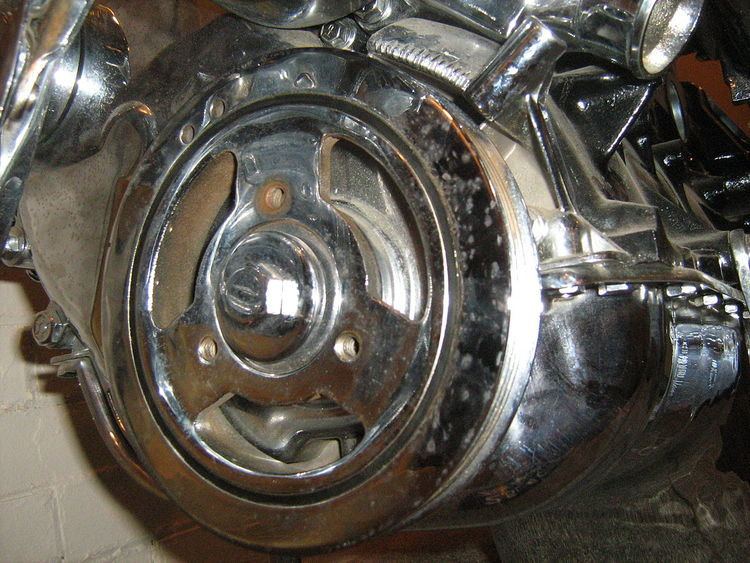 | ||
A harmonic balancer (also called harmonic damper, crankshaft damper, torsional damper, or vibration damper) is a harmonic damper with weights mounted on it to externally balance the rotating assembly. The device is connected to the crankshaft of an engine to counter torsional crankshaft motion and Harmonic vibration. The device can also serve as a pulley for the accessory drive belts turning the alternator, air conditioning, air pump, power steering pump, water pump of other crank driven devices. This device must be interference fit to the crankshaft in order to operate in an effective manner. An interference fit ensures the device moves in perfect step with crankshaft.
Contents
Torsional crankshaft movement and harmonics
Each time a cylinder fires the force of the combustion is imparted to the crankshaft rod journal. The rod rod journal deflects in a torsional motion to some degree under this force. In one form Harmonics occur as a results of the torsional motion imparted on the crankshaft. These harmonics are a function of many factors from frequencies created by the actual combustion to the natural frequencies the metals make under the stresses of combustion and flexing. Some engines at certain speeds can have a sync of the torsional motion with the harmonics of the crankshaft, which can results in a resonance. In some case this resonance could cause stress beyond what the crankshaft can withstand, resulting in crankshaft cracking or complete failure.
Countering torsional crank motion and harmonic vibration
This device helps minimize torsional crank motion and harmonics. The damper is composed of two elements: an inertia mass and an energy dissipating element (elastomer/clutch/fluid/spring). The mass counteracts the torsional crank motions and in concert with the energy dissipating element absorbs the harmonics.
Maintenance
Over time the energy dissipating element (elastomer/clutch/fluid/spring) can deteriorate from age, heat, cold, exposure to oil or chemicals. Unless rebuilt or replaced the device could failpossibly cause the crankshaft to develop cracks.
Engine design, materials, and other factors
Over time engine development has continually advanced in almost all areas from material, operation and function. Many of the advances were led by the Japanese manufacturers as they have made quality and durability the cornerstone of they programs. The Japanese advanced the proliferation of forged crankshafts with rotating assemblies at 0 gram balance. Forged crankshafts are much stronger, significantly less apt to exhibit detrimental torsional crankshaft movement which also mitigates harmonic frequencies. This progression has also seen the addition of forged rods and pistons initially in forced induction engines and more recently in normally aspirated engines. Adding these additional forged components ramps the engines rigidity reducing concern about crankshaft damage even further. With the advent of computer aided design and finite element analysis manufacturers can now find and re-engineer weaker areas. Regardless of some of these improvements certain engines like the traditional V8 which has a firing order by nature prone to excessive harmonics necessitating the use of this device. The flat plane V8, traditionally used in more exotic engines, does not suffer from the excessive harmonics and therefore may use a solid undampened device. Modern (roughly 1988+) DOHC, SOHC Flat 4, I4, Flat 6, I6, V6, Flat 8, Flat Plane V8 have no need for this device. Over the years many of these engines use solid cast iron or aluminum crank pulley or audible NVH damper (reducing engine noise heard in the occupant compartment). Audible NVH has been the biggest factor in OE manufacturer decisions thoughout the vehicle. In addition the pulleys on these engines are mounted loosely with a location fit negating any potential to acrt as an engine protective damper. Continental has recently provided detailed information on the maximum acceptable noise (NVH) that should be heard from under the hood from the engine in their Elite Belt program http://www.thequietbelt.com/#the-art-of-silence
Effects of removal
Some performance enthusiasts have been known to remove these devices, deciding they aren't necessary as their mass reduces engine performance. Removal of the device from a traditional V8 is very risky due to the potential danger of damage to the crankshaft. If the device has weight mounted on it to balance the rotating assembly the effects would be felt immediately and would be catastrophic.
